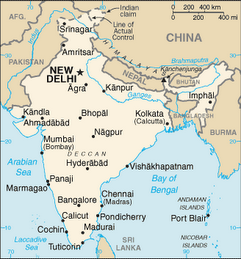 As my plane touched down in Calcutta, I harbored innumerable expectations about a city I've wanted to visit for the past year. The capital of West Bengal, Calcutta, or Kolkata as it can now be called, is a sprawling mass of over 13 million people, most of them very poor. It's the home of Bengali sweets, of Tagore and other intellectuals who have defined Indian literature; it is the former British East India Company capital, and the site of Mother Theresa's tomb. It hosts the famous cricket ground Eden Gardens, the beautiful Victoria Memorial, and the posh Park Street.
As my plane touched down in Calcutta, I harbored innumerable expectations about a city I've wanted to visit for the past year. The capital of West Bengal, Calcutta, or Kolkata as it can now be called, is a sprawling mass of over 13 million people, most of them very poor. It's the home of Bengali sweets, of Tagore and other intellectuals who have defined Indian literature; it is the former British East India Company capital, and the site of Mother Theresa's tomb. It hosts the famous cricket ground Eden Gardens, the beautiful Victoria Memorial, and the posh Park Street.Today it is a city that lags behind Delhi and Bombay, but also a city that quite resembles its ostensibly more developed counterparts. Upon arrival I expected images of destitution I hadn't yet seen across the sub-continent, as even my Indian friends warned me against going to Calcutta. I was told that traffic signals had only arrived a decade ago, and that infrastructure would be difficult.
In contrast to expectations set by Indian friends, what I found was a city that, to me, was unremarkably Indian. It was certainly no better than other Indian cities I have seen and experienced over the past year, but it was also certainly no worse. And despite its apparent status as a scapegoat city for many Indian natives, the challenges Calcutta has yet to overcome are the same as those extant elsewhere, yet it bears the sour reputation. While traffic signals may have only come in the past decade, Calcutta traffic was markedly better than Gurgaon, Hyderabad, and Bangalore, cities engineered in much more recent years.
Bubbles of developed infrastructure exist across India, but single stretches of highway in Delhi cannot assuage underlying problems in urban planning. In venturing into West Bengal's notorious capital, I was struck not by the penury, but by how remarkably similar it was to other purportedly developed Indian cities.



No comments:
Post a Comment